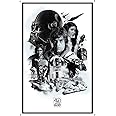Pulp fiction, a term originally used to describe low-cost fiction magazines published in the early 20th century, has become synonymous with thrilling narratives, vivid characters, and sensational artwork. This genre not only transformed literature but also gave rise to an iconic visual culture, particularly through its striking posters. This article explores the evolution of pulp fiction, highlighting its memorable posters and the cultural significance they hold.
The Birth of Pulp Fiction

The term “pulp fiction” derives from the cheap, low-quality paper (pulp) used to print magazines from the 1890s through the 1950s. These magazines featured a variety of genres, including crime, science fiction, horror, and adventure. They catered to a burgeoning audience that craved escapism during a time of economic turmoil and social change. Some of the most famous titles included “Weird Tales,” “Black Mask,” and “Astounding Stories.”
- Initial Popularity: The rise of affordable literature allowed for a boom in readership among the working and middle classes.
- Genres and Themes: Pulp fiction often tackled themes of crime, romance, and the supernatural, which appealed to the public’s imagination.
- Cultural Resonance: Pulp fiction tapped into the anxieties and fascinations of its time, mirroring societal issues such as crime rates, gender roles, and technological advancements.
The Role of Art in Pulp Fiction
One of the defining characteristics of pulp fiction magazines was their cover art. These artworks were crucial in attracting readers and often depicted dramatic scenes, alluring characters, and sensational action, creating a visual narrative that complemented the written story.
The Golden Age of Pulp Covers

The 1930s to the 1950s is often considered the golden age of pulp magazine covers. Artists like Frank R. Paul, Robert Gibson Jones, and H.J. Ward became famous for their work in this genre. The covers not only sold the magazines but also established a visual language that would influence future media.
- Frank R. Paul: Known for his vivid imagination, Paul’s science fiction covers often featured fantastical landscapes and alien creatures.
- H.J. Ward: Ward’s work in “Weird Tales” showcased a blend of horror and fantasy, encapsulating the eerie essence of the stories.
- Robert Gibson Jones: His covers often featured strong female characters, challenging traditional gender roles and appealing to a diverse audience.
Iconic Posters of the Pulp Era

As pulp fiction transitioned into film and television, the visual style of pulp posters evolved. The vibrant artwork of pulp magazine covers influenced the design of movie posters, capturing the essence of the stories while appealing to broader audiences. Let’s explore some memorable examples.
Film Noir Posters
The film noir genre, which blossomed in the 1940s and 1950s, was heavily influenced by pulp fiction’s crime stories. Posters from this era often featured stark contrasts between light and shadow, embodying the moral ambiguity of the narratives.
- Double Indemnity (1944): The poster’s use of chiaroscuro highlighted the tension and deceit at the heart of the film.
- The Maltese Falcon (1941): Featuring a brooding Humphrey Bogart, this poster captured the essence of mystery and intrigue.
The Science Fiction Boom

The 1950s saw a significant rise in science fiction films, many of which were inspired by pulp magazine stories. The posters for these films often featured imaginative and sometimes absurd depictions of alien worlds and futuristic technology.
- Forbidden Planet (1956): The poster showcased a vibrant, otherworldly landscape, drawing viewers into a thrilling adventure.
- The Day the Earth Stood Still (1951): Featuring the iconic robot Gort, the poster encapsulated the fear and fascination of the atomic age.
Horror and Fantasy Art
Pulp fiction’s influence extended into the horror and fantasy genres, leading to some of the most memorable poster art in film history. These posters often used surreal imagery to evoke a sense of fear and wonder.
- Dracula (1931): The original poster art depicted the infamous Count in a striking pose, creating an atmosphere of dread.
- The Thing from Another World (1951): The poster art emphasized the terror of the unknown, aligning perfectly with the film’s themes.
Modern Interpretations and Revival
In recent years, the influence of pulp fiction has seen a revival, with both filmmakers and artists drawing inspiration from the aesthetic and storytelling techniques of the past. Graphic novels, indie films, and retro-style posters have embraced the vivid imagery and bold narratives that defined the genre.
Contemporary Pulp Culture

Numerous contemporary creators have sought to capture the essence of pulp fiction, merging it with modern sensibilities. Notable examples include:
- Sin City (2005): Frank Miller’s graphic novels and their subsequent film adaptations drew heavily from the visual style of pulp noir.
- Drive (2011): This film’s posters evoke a retro aesthetic, reminiscent of classic pulp covers while offering a modern twist.
Poster Art Today
Today, poster art continues to play a critical role in marketing films and books, often echoing the styles of classic pulp covers. Artists such as Matt Owen and Olly Moss have gained recognition for their retro-inspired designs, breathing new life into the pulp tradition.
The Lasting Impact of Pulp Fiction Posters

The legacy of pulp fiction posters extends beyond mere aesthetics; they reflect cultural shifts, societal anxieties, and the evolution of storytelling itself. Their bold imagery and captivating narratives have influenced not only literature and cinema but also graphic design, marketing, and popular culture.
- Visual Storytelling: Pulp posters have shaped our understanding of visual narratives and their power to convey complex emotions.
- Cultural Reflection: They serve as historical artifacts that capture the zeitgeist of their times, offering insights into social values and fears.
- Enduring Appeal: The allure of pulp fiction continues to resonate, inspiring new generations of writers, artists, and filmmakers.
The evolution of pulp fiction and its accompanying posters is a fascinating journey through the annals of popular culture. From the early magazines that captivated readers with their sensational stories and striking covers to the modern interpretations that pay homage to this rich tradition, pulp fiction has left an indelible mark on literature and art. The memorable posters, with their vibrant colors and imaginative designs, not only reflect the stories they represent but also embody the cultural shifts of their times. As we look back on this legacy, it is clear that pulp fiction remains a vital part of our creative landscape, continuing to inspire and engage audiences around the world.




